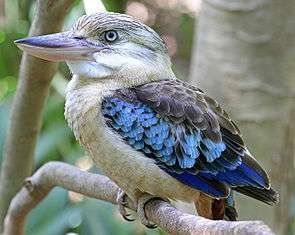Coraciimorphae
| Coraciimorphae | |
|---|---|
 | |
| Blue-winged kookaburra, Dacelo leachii | |
| Scientific classification | |
| Kingdom: | Animalia |
| Phylum: | Chordata |
| Class: | Aves |
| Clade: | Afroaves |
| Clade: | Coraciimorphae Sibley & Ahlquist, 1990 |
| Subclades | |
Coraciimorphae is a clade of birds that contains the order Coliiformes (mousebirds) and the clade Eucavitaves (a large assemblage of birds that includes woodpeckers, kingfishers and trogons).[1][2][3][4] The name however was coined in the 1990s by Sibley and Ahlquist based on their DNA-DNA hybridization studies conducted in the late 1970s and throughout the 1980s.[5] However their Coraciimorphae only contain Trogoniformes and Coraciiformes.
| Coraciimorphae |
| ||||||||||||||||||||||||||||||
| |
Cladogram of Coraciimorphae relationships based on Jarvis, E.D. et al. (2014)[4] with some clade names after Yury, T. et al. (2013).[6]
References
- ↑ Hackett, S.J.; et al. (2008). "A Phylogenomic Study of Birds Reveals Their Evolutionary History". Science. 320: 1763–8. doi:10.1126/science.1157704. PMID 18583609.
- ↑ Ericson, P.G. (2012). "Evolution of terrestrial birds in three continents: biogeography and parallel radiations" (PDF). Journal of Biogeography. 39 (5): 813–824. doi:10.1111/j.1365-2699.2011.02650.x.
- ↑ Naish, D. (2012). "Birds." Pp. 379-423 in Brett-Surman, M.K., Holtz, T.R., and Farlow, J. O. (eds.), The Complete Dinosaur (Second Edition). Indiana University Press (Bloomington & Indianapolis).
- 1 2 Jarvis, E. D.; Mirarab, S.; Aberer, A. J.; et al. (2014). "Whole-genome analyses resolve early branches in the tree of life of modern birds". Science. 346 (6215): 1320–1331. doi:10.1126/science.1253451. PMC 4405904
 . PMID 25504713.
. PMID 25504713. - ↑ Sibley, Charles Gald & Ahlquist, Jon Edward (1990): Phylogeny and classification of birds. Yale University Press, New Haven, Conn.
- ↑ Yuri, T.; et al. (2013). "Parsimony and Model-Based Analyses of Indels in Avian Nuclear Genes Reveal Congruent and Incongruent Phylogenetic Signals". Biology. 2 (1): 419–444. doi:10.3390/biology2010419.